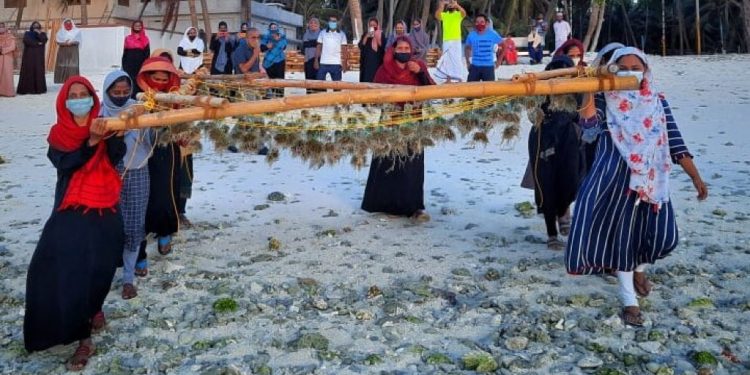Kochi: After fisheries, coconut and tourism, the Lakshadweep administration has prioritised seaweed farming as the next major development driver of the islands.
A demonstration farming of seaweed was launched in nine inhabited islands of Lakshadweep with the technical support of the Indian Council of Agricultural Research (ICAR) and the Kochi headquartered Central Marine Fisheries Research Institute (CMFRI).
The large-scale initiative is in line with a CMFRI study that revealed immense potential for production of quality seaweeds in serene and pollution-free lagoons of Lakshadweep for high-end utilisation like the pharmaceuticals, food and nutraceuticals.
The indigenous red algae, Gracilaria edulis and Acanthophora spicifera are the species being farmed in nearly 2,500 bamboo rafts benefitting 100 families belonging to 10 women self-help groups in different islands.
CMFRI scientist K. Mohammed Koya said the island is known for its unique tuna fisheries and myriads of beautiful corals, reef fishes and other creatures.
“Now the marine sphere of the islands are more likely to be known as the seaweed farming hub of India soon,” Koya added.
Recent studies by the CMFRI revealed an unprecedented growth performance of indigenous seaweed species in various lagoons of Lakshadweep with nearly 60-fold growth in 45 days for the species Gracilaria edulis.
Following the early success, the Lakshadweep administration joined hands with the CMFRI for multi-locational trial farming and capacity building of stakeholders.
Thus, experimental-scale trial farming was conducted in the islands of Kiltan, Chetlah Kadmath, Agatti and Kavaratti during 2020-21 with promising results.
“The studies revealed that the island territory has a potential of producing nearly 30,000 ton of dry seaweed per year worth Rs 75 crore by farming only 1 per cent (200 hectare) of its 21,290 hectare lagoon area (inhabited islands only) at the rate of a modest 150 ton per hectare”, Koya added.
Terming it as a climate-smart initiative, he further said, “The sea being the major sink of carbon and the seaweeds well-known for its carbon sequestration properties, the farming of seaweed at such a scale would sequester nearly 6500t carbon dioxide per day adding a huge carbon credit to the nation while providing a climate-resilient livelihood to the islanders,” said CMFRI scientist.
Providing a sound scientific basis for a sustainable seaweed farming enterprise, the CMFRI and the Lakshadweep Krishi Vigyan Kendra of the CMFRI is conducting further studies for assessing the carrying capacity of the lagoons, spatial mapping of suitable farming sites, standardising farming methods for year-round farming in deeper areas and means to ensure quality seeding materials of indigenous seaweed species jointly with the Lakshadweep administration.
IANS






































